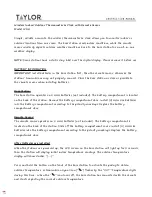
USER INSTRUCTIONS
E
N
G
L
I
S
H
33
F.A.Q.
What does the temperature value on the display actually represent?
If no external temperature probe is enabled during ETS programming, the value shown
on the display is the temperature detected by the sensor in the thermostat.
If, however, an external temperature probe (of the KNX or NTC type) has been enabled,
the thermostat shows the average of the values detected by the probe and the sensor,
using a variable weight between 10% and 100% (which can be defined via ETS).
The temperature shown on the display (measured by the internal sensor) does not
vary, even in the face of heat variations. Why?
Following the intensive use of the device (e.g. during the programming phases) with the
backlighting enabled, there may be slight alterations in the local temperature, so the
device prevents the updating of the measurement for a few minutes in order to guarantee
the accuracy of the measurement in these conditions too.
Can the temperature of an external KNX probe (e.g. temperature adjustment probe
GW1x799, or the one on a 6-channel push-button panel GW1x783 or a 6-channel
push-button touch panel GW10746) be visualised?
If the thermostat is configured (during ETS programming) to manage a KNX probe, the
temperature measured by that probe can be viewed on the display; press the
button
key on the visualisation page of the corresponding remote element, as explained in
Visualising the remote elements
on page 12.
How is the humidity value measured?
The timed thermostat does not have its own humidity sensor, so the relative humidity
value must be supplied by an external KNX sensor (e.g. GW1x762H).




































